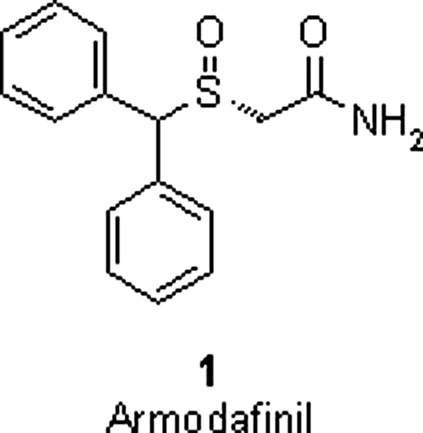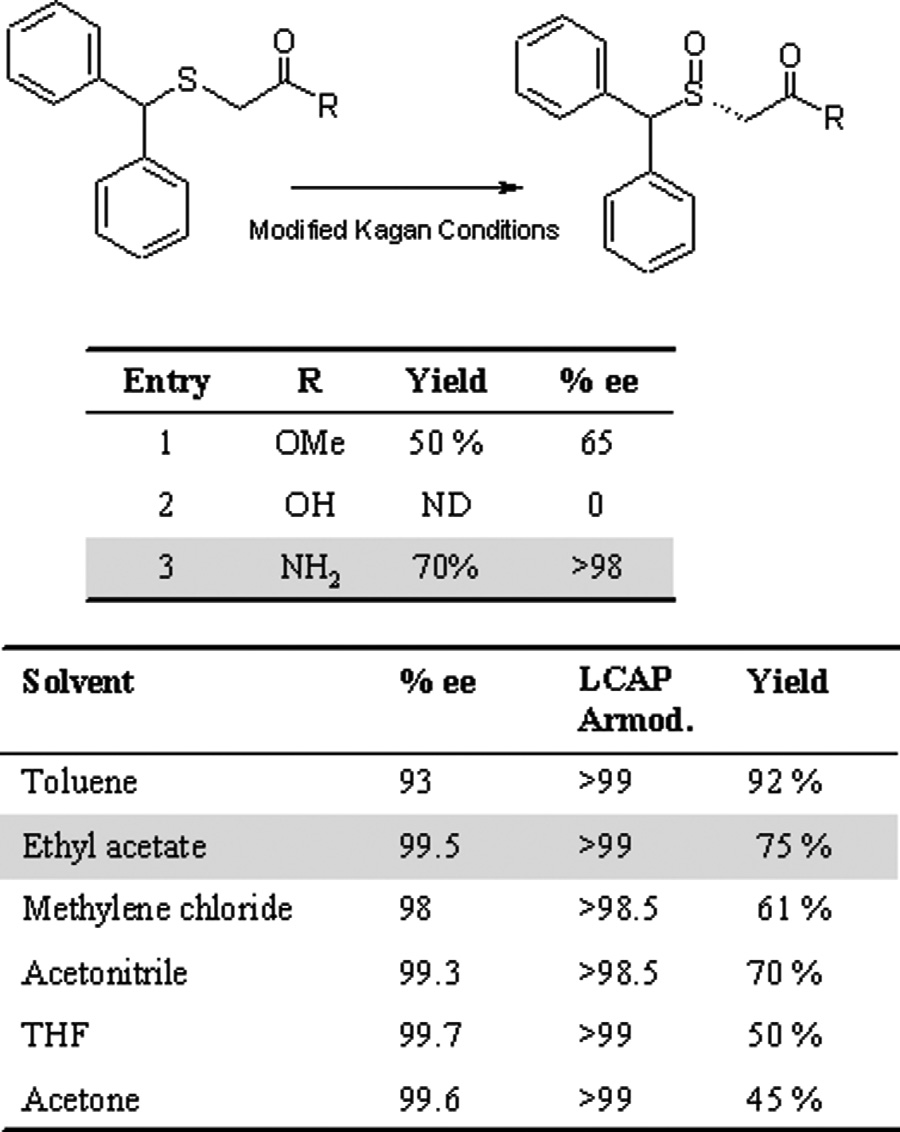C2chi#080035 1.4

J_ID: CHI Customer A_ID: 08-0027 Cadmus Art: CHI20564 Date: 23-MAY-08 Stage: I
CHIRALITY 00:000–000 (2008)
Use of Large-Scale Chromatography in the
Preparation of Armodafinil
WILLY HAUCK,1 PHILIPPE ADAM,2 CHRISTELLE BOBIER,2* AND NELSON LANDMESSER3
1Novasep Inc., Boothwyn, Pennsylvania
2Novasep SAS, Pompey, France
3Cephalon Inc., West Chester, Pennsylvania
Armodafinil, the (R)-enantiomer of modafinil, is a medication used to
treat the excessive sleepiness associated with narcolepsy, obstructive sleep apnea/hypo-pnea syndrome, and shift work sleep disorder. We report here the chemical develop-ment of armodafinil and the investigations that led to a commercial route to prepare thispure enantiomer. Three synthetic approaches were used to provide the chiral sulfoxide.
Resolution via preferential crystallization was used for phase I clinical trials and was sub-sequently replaced by chiral chromatography, enabling us to pursue a rapid filing andregistration of the API. Finally, the commercial route was developed and employedasymmetric oxidation catalyzed by a titanium(IV) isopropoxide and diethyl tartrate sys-tem. The advantages of choosing a chromatographic development pathway to expediteregistration while concurrently developing an economical chiral synthesis route isdiscussed
C 2008 Wiley-Liss, Inc.
KEY WORDS: continuous chromatography; chiral chromatography; asymmetric oxidation;
asymmetric synthesis; preferential crystallization; armodafinil; chiral sulf-oxide; preparative HPLC; continuous processes
tam (Keppra1), radafaxine, and pagoclone3 are produced
via chromatography and demonstrate how powerful chiral
chromatography can be. Commercial production at tons
1) is a wakefulness-promoting agent used for the
treatment of excessive sleepiness associated with narco-
to 100s tons scale shows it can be the most cost-effective
lepsy, obstructive sleep apnea, and shift work sleep disor-
production method for chiral manufacturing.
der. Armodafinil is a second generation therapy and is a
Preparative HPLC can be easily scaled-up for production
single enantiomer formulation of modafinil that has been
of pure enantiomers by transposing analytical conditions
approved for the same indications.
to a larger column and increasing amounts of feed
The challenge in this process development was to find a
injected. Continuous chromatography (SMB, VARICOL1)
viable and economic synthetic route while also shortening
is designed for binary separations and is very well adapted
development times to introduce the product more quickly
for chiral resolution of a racemate. The optimization of
to the market. It was, therefore, interesting to choose a
these processes is done after just a few laboratory meas-
continuous chiral chromatographic process, to file the mol-
urements and the application of modeling and simulation
ecule as soon as possible and concurrently work on the
software. The development and optimization of continuous
asymmetric process development in the laboratory for the
chromatography can take place in parallel with the first
long-term commercial supply. This strategy can be suc-
production by HPLC in order to save time.
cessful and allows the pharmaceutical company to reduce
To prepare armodafinil by chiral chromatography, the
the time to market launch by up to 2 yr.
simplest route was to resolve readily available racemic mod-afinil.4 The strategy that we developed was the following:
• To determine solubility of substrate in common eluent
• To screen a large number of chiral stationary phases
HPLC is well known by analytical specialists as a power-
(CSPs) and chiral intermediates,
ful method for both optical and chemical purity measure-ment. Unfortunately, chromatography is rarely considered
*Correspondence to: Christelle Bobier, Novasep SAS, Pompey, France.
as a way of pure enantiomer production, even if it is a
E-mail: christelle [email protected]
good alternative to the other techniques.1
Received for publication 7 February 2008; Accepted 13 February 2008
DOI: 10.1002/chir.20564Published online in Wiley InterScience
(Zoloft1),2 escitalopram (Cipralex1/Lexapro1), levitirace-
C 2008 Wiley-Liss, Inc.
ID: veeraragavanb


J_ID: CHI Customer A_ID: 08-0027 Cadmus Art: CHI20564 Date: 23-MAY-08 Stage: I
HAUCK ET AL.
5 0.48 kg (R)-modafinil/kg CSP/day). The VARICOL1Lab was operated under these conditions for a period ofover 10 days in order to process 1 kg of feed material andto assess the eluent recycling. The parameters imple-mented in the VARICOL1 production were within therange of the predicted parameters as defined in the simu-lation study.
The numerical simulation showed that better perfor-
mances (purity, productivity, and yield) were obtainedwith the VARICOL1 process when compared with theSMB process, and also defined an upper limit for (S)- and
Fig. 1. Structure of Armodafinil (2-[(R)-(diphenylmethyl)sulfinyl]aceta-
(R)-modafinil content in the recycled eluent. On the otherhand, maximum water content in the eluent was experi-mentally set at 5000 ppm. Content of nondesired enan-
• To optimize the eluent system for use with the selected
tiomer was set to a limit 60.007 g/l for the mobile phase
and 61 g/l when the eluent is used for feed preparation.
• To demonstrate the selected conditions on analytical
For phase III clinical supply, 540 kg of (R)-modafinil
and pilot scale, and
(99% o.p.) was produced on a VARICOL1 unit composed
• To develop a process for large-scale separation.
of six columns of 20-cm I.D. packed with Chiralpak AD20 lm as stationary phase and using pure methanol as
During the development study, the aim was to select
mobile phase. The productivity obtained during the 8 mo
the most productive and robust stationary phase and mo-
production campaign was 0.5 kg (R)-modafinil/kg CSP/
bile phase for the separation of modafinil enantiomers.
day, chromatographic yield was 93% and recovery yield
Our method development typically began with a screening
of (R)-modafinil, including subsequent drying process,
of different CSPs (from Daicel, Shiseido, Kromasil, Merck
was 77.6%. The optical purity of the desired enantiomer
KgaA or Regis) and a screening of different eluents
was greater than 99.2% and the chemical purity was
(ethanol, methanol, heptane, isopropanol, or a mix of
them). Based on the analyte solubility (greatest in MeOH
The next step of the study was to characterize the (R)-
20 g/l at 208C), selectivity and productivity, Chiralpak AD
modafinil separation robustness from a racemate feed
20 lm (Chiral Technologies) was selected as the CSP for
stock with a new impurity profile on a VARICOL1 Lab
the process. Conditioning of the CSP with isopropanol
pilot unit. This study provided the necessary information
after column packing and prior to the VARICOL1 separation
to define critical parameters and their proven acceptable
in methanol was found to improve the efficiency and selec-
ranges; to determine the maximum impurity levels needed
tivity of the separation and contributed to the robustness
to reach chemical purity specifications; to evaluate the
of the final process.
new packing batches using the new feed stock (CSP stabil-
A complementary study was performed to define the
ity, protocol for IPA conditioning, residual content of IPA
appropriate conditions on a 30-cm I.D. column HPLC.
in methanol); and to evaluate the stability of purified (R)-
When 5 mg were injected onto the analytical column, ev-
modafinil in its solid form (at 40 and 658C for 8 days under
ery 4 min, (R)-modafinil was recovered within specifica-
tions of yield (90%) and purity (99.0%). The corresponding
A rationale was developed to define the residence time
amount to be injected onto the 30-cm I.D. column is 21.27
of rac-modafinil, (R)-modafinil, and methanolic solutions to
g per injection.
control the stability profile in the continuous chiral separa-
With these studies in hand, the separation was carried
tion process including process validation batches and pro-
out using a 30-cm I.D. HPLC column installation. For the
duction of commercial launch quantities. On an industrial
early clinical studies, a total of 61.3 kg of (R)-modafinil
VARICOL1 unit (composed of six columns of 30-cm I.D.),
were produced with a yield of 93%. During three consecu-
the stationary phase was stable after the processing of 10
tive batches of this first production campaign, the specific
metric tons of racemate.
productivity obtained was 0.3 kg (R)-modafinil/kg CSP/
Chiral chromatography quickly produced the required
day. The optical purity was between 99.2 and 99.7% and
amount of armodafinil for clinical trials and registration of
the chemical purity was more than 99.9%. This amount of
the molecule. The development of the method from the
(R)-modafinil was obtained over 3 mo.
feasibility study to the scale-up and process validation at
In parallel with the HPLC production campaign and with
three different commercial production sites equipped with
the perspective of large-scale production, a pilot study on a
two unit sizes (30- and 45- cm I.D. columns) took only
VARICOL1 Lab system, equipped with six columns of 2.5-
cm I.D., was run to demonstrate the feasibility of the pro-
Eventually, chiral chromatography will not be selected
cess and to identify robust operating conditions for pro-
as the route for long-term commercial production. Racemi-
duction on the VARICOL1 6-200 (six columns of 20-cm
zation of the undesired enantiomer was not possible for
I.D.). The operating ranges were characterized by numeri-
this molecule, and the starting material (modafinil) is
cal simulations and the working conditions were found
costly. We, therefore, had to develop a more cost-effective
through this process demonstration (specific productivity
Chirality DOI 10.1002/chir
ID: veeraragavanb



J_ID: CHI Customer A_ID: 08-0027 Cadmus Art: CHI20564 Date: 23-MAY-08 Stage: I
PREPARATION OF ARMODAFINIL BY CHROMATOGRAPHY
Fig. 2. Formation of Modafinic acid and conversion to Modafinil.
theoretical yield for any crystallization process is only 50%.
A classical method useful for the separation of enantiom-
Since it seemed that this process would not prove to be
ers is the preparation and fractional recrystallization of
adequately robust on commercial scale, it was decided to
their respective diasteromeric salts. This well-known
focus resources on an asymmetric synthesis.
method is only possible when the racemate to be resolvedis capable of forming a diasteromeric salt and when the
ASYMMETRIC SYNTHESIS
purified enantiomer can be regenerated from the salt.
A strategy for the asymmetric synthesis of armodafinil
Another method for the separation of enantiomers involves
was developed based upon the groundbreaking work of
the preferential crystallization of a conglomerate, when a
Kagan and coworkers.6 This chemistry utilizes a chiral tita-
racemate exists as a true eutectic mixture. This situation is
nium complex catalyzed cumene hydroperoxide oxidation
estimated to apply to about 5% of all organic compounds.
of a sulfide substrate to provide chiral sulfoxides with
During the early stage of armodafinil development, it
good optical activity. We found the Kagan method to be
was discovered that an intermediate in the synthesis of ra-
quite useful but also to be substrate dependant. Several
cemic modafinil could be easily converted to its carboxylic
sulfide derivatives of modafinil were screened to deter-
acid derivative and that the derivative, modafinic acid,
mine a starting point for optimization. From this initial
exists as a true eutectic mixture or conglomerate. This
screen, the sulfide amide substrate provided excellent op-
conglomerate could be separated into its correspondingenantiomers by preferential crystallization, utilizing anauto-seeded programmed polythermal preferential crystal-lization (AS3PC) method5 (see Fig.
The AS3PC method of preferential crystallization takes
advantage of the unique quality of conglomerates and aprotocol that involves seeding a solution of the racematewith one of the pure enantiomers. This seeding processresults in the crystallization of the enantiomer that now ispresent in excess. Filtration to collect the solid providesthe first enantiomer in high chiral purity, while the motherliquor remaining is now highly enriched in the secondenantiomer. At this point in the process, additional race-mate is added to the mother liquor. The resulting solutionis now enriched in the second enantiomer which crystalli-zes again in high chiral purity. Upon collection of the sec-ond enantiomer by filtration, the mother liquor thatremains is now highly enriched in the first isomer. By add-ing additional racemate to the solution, the cycle isextended and both of the enantiomers can be harvested inalternating batches. In the case of modafinic acid, we haveprocessed enantiomers through over 35 cycles in a pilotplant cGMP environment. A total of 85 kg of (R)-modafinicacid was produced by this method over four batches. Theoptically pure acid was subsequently converted to the APIin a two-step synthetic process.
Although the AS3PC method of preferential crystalliza-
tion allowed us to provide API for early preclinical and
Fig. 3. Effect of substrate and solvent on the yield and enantiomeric
clinical studies, we quickly realized that the process was
excess of the asymmetric oxidation. (LCAP Armod. Is the liquid chroma-
limiting and labor intensive. In the absence of a process
tography area percent of Armodafinil. It is a measure of the chemicalpurity.) [Color figure can be viewed in the online issue, which is available
for the racemization of the undesired enantiomer, the
Chirality DOI 10.1002/chir
ID: veeraragavanb

J_ID: CHI Customer A_ID: 08-0027 Cadmus Art: CHI20564 Date: 23-MAY-08 Stage: I
HAUCK ET AL.
HPLC was used to supply the API for early clinical trials,while the optimization, validation, and multisite implemen-tation of a commercial production was achieved usingVARICOL1 continuous chromatography.
For this particular program, the chiral separation was
the final process step, and the undesired enantiomer couldnot be recycled by racemization. Consequently, the globalyield and cost of goods were not the most favorable. Asthe chromatographic process guaranteed the scale-up andthe supply of Armodafinil, we could develop in parallel anefficient asymmetric synthesis that further improved costof goods and could be introduced as a postapproval
Fig. 4. Asymmetric synthesis of Armodafinil.
change for long-term commercial production.
This example shows that chiral chromatography should
tical purity and was identified as a starting point for further
be systematically evaluated for large-scale API manufactur-
optimization (see Fig.
ing to shorten the time to market even, if the ultimate cost
Once the sulfide amide was identified as the preferred
of goods targets cannot be achieved with the technology.
substrate, a group of several parameters were studied inan effort to optimize the conditions for maximizing yield
and chiral purity. The parameters studied included were
Cephalon: John Mallamo, Conrad Kowalski, Gilles Ser-
the following: the choice of solvent, water stoichiometry,
rure, Gerard Duret, Laurence Prat, Francois Rebiere,
Ti catalyst stoichiometry, (S,S)-DET (diethyl tartrate) stoi-
Pierre Leproust, Ste´phanie Graf, Laurent Courvoisier,
chiometry, cumene hydroperoxide stoichiometry, and cat-
Domonique Klien, Guy Piacenza, Sebastien Rose, Nelson
alyst contact time. The final optimized conditions provided
Landmesser, Stuart Dodson, and Michael Kress. Chiral
an asymmetric oxidation process suitable for commercial
Technologies: James Lee and Tom Lewis. Novasep: Jean
scale manufacturing yielding the API in 75% isolated yield
Ble´haut, Fe´licie Denet, Manuel Marques, Yvan Ruland,
and >99.5% optical purity.7
Eric Lang, Kevin Duffield. IRCOF–University of Rouen:
The asymmetric oxidation offers several advantages
Prof. Ge´rard Coquerel, Marie-Noe
¨lle Petit, Franck Mallet,
over the separation processes. The process begins with
and Nicolas Wermester.
relativity cheap achiral raw materials and overall is a truecatalytic process. The result is a process that is economi-cally favorable as compared with separation methods. In
addition, the armodafinil isolated from the asymmetric
1. Francotte ER. Enantioselective chromatography as a powerful alterna-
synthesis process is typically >99% chemical purity and
tive for the preparation of drug enantiomers. J Chromatogr A
>99.5% optical purity and meets the specification in every
way for API armodafinil. The final commercial manufactur-
2. Quallich GJ. Development of the commercial process for Zoloft/Ser-
traline. Chirality 2005;17:S120–S126.
ing process is shown below (see Fig.
3. Stuk TL, Assink BK, Bates RC, Erdman DT, Fedij V, Jennings SM,
Lassig JA, Smith RJ, Smith TL. An efficient and cost effective synthe-sis of Pagoclone. Org Process Res Dev 2003;7:851–855.
4. Hauck W, Ludemann-Hombourger O, Ruland Y, Landmesser N, Mallamo
Chiral chromatography enabled us to shorten the time
J. Methods for the separation of modafinil. Int. Patent WO 2006/030278.
to regulatory submission and approval of Nuvigil1 (armo-
5. Collet A, Brienne MJ, Jacques J. Optical resolution by direct crystalli-
dafinil). The process also provides extremely pure API for
zation of enantiomer mixtures. Chem Rev 1980;80:215–230.
clinical use. This is a testament to the purity of modafinil,
6. Brunel J-M, Diter P, Duestsch M, Kagan HB. Highly enantioselective
the starting material for the process, and the value of
oxidation of sulfides mediated by a chiral titanium complex. J OrgChem 1995;60:8086.
large-scale chiral chromatography as a purification tool.
7. Rebiere F, Duret G, Prat L. Process for enantioselective synthesis of
The large-scale preparation of armodafinil was quickly
single enantiomers of modafiniland related compounds by asymmetric
achieved, thanks to chromatography. Classical batch
oxidation. Int. Patent WO 2005/028428.
Chirality DOI 10.1002/chir
ID: veeraragavanb
Source: http://h5512.novius.net/media/articles-and-publications/84v%204-%20use%20of%20large%20scale%20chromatography%20in%20the%20preparation%20of%20armadafinil.pdf
J Korean Neurosurg Soc 43 : 143-148, 2008 Incidence and Risk Factors of Acute Yoon-Sik Oh, M.D.1 Postoperative Delirium in Geriatric Dong-Won Kim, M.D.2 Hyoung-Joon Chun, M.D.1 Hyeong-Joong Yi, M.D.1 Objective : Postoperative delirium (POD) is characterized by an acute change in cognitive function and canresult in longer hospital stays, higher morbidity rates, and more frequent discharges to long-term care facilities.In this study, we investigated the incidence and risk factors of POD in 224 patients older than 70 years ofage, who had undergone a neurosurgical operation in the last two years.Methods : Data related to preoperative factors (male gender, >70 years, previous dementia or delirium, alcoholabuse, serum levels of sodium, potassium and glucose, and co-morbidities), perioperative factors (type ofsurgery and anesthesia, and duration of surgery) and postoperative data (length of stay in recovery room,severity of pain and use of opioid analgesics) were retrospectively collected and statistically analyzed.Results : POD appeared in 48 patients (21.4%) by postoperative day 3. When we excluded 26 patients with
Jefferson Elementary School Our Mission Jefferson Elementary The Mission of Jefferson Elementary School is to provide all students with Student, Parent/Guardian educational opportunities which Handbook enable them to become 2007-2008 life-long learners. "My father has always taught










